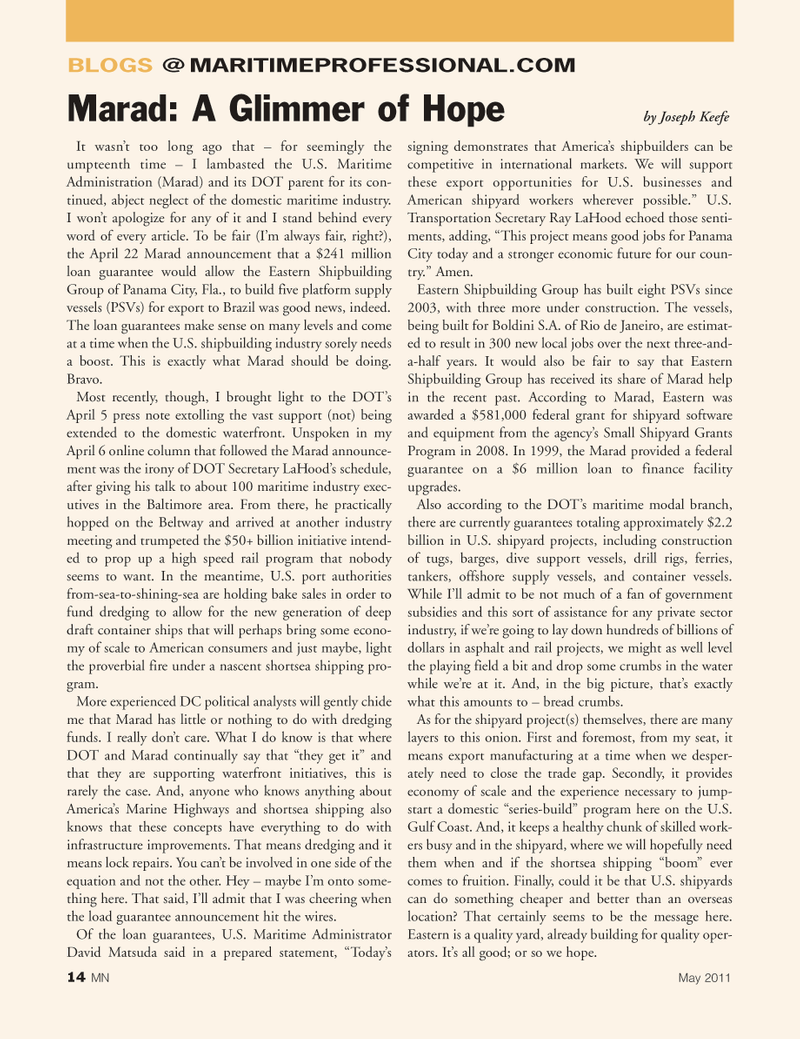
Page 14: of Marine News Magazine (May 2011)
Combat Craft Annual
Read this page in Pdf, Flash or Html5 edition of May 2011 Marine News Magazine
14 MN May 2011
It wasn’t too long ago that – for seemingly the umpteenth time – I lambasted the U.S. Maritime
Administration (Marad) and its DOT parent for its con- tinued, abject neglect of the domestic maritime industry.
I won’t apologize for any of it and I stand behind every word of every article. To be fair (I’m always fair, right?), the April 22 Marad announcement that a $241 million loan guarantee would allow the Eastern Shipbuilding
Group of Panama City, Fla., to build five platform supply vessels (PSVs) for export to Brazil was good news, indeed.
The loan guarantees make sense on many levels and come at a time when the U.S. shipbuilding industry sorely needs a boost. This is exactly what Marad should be doing.
Bravo.
Most recently, though, I brought light to the DOT’s
April 5 press note extolling the vast support (not) being extended to the domestic waterfront. Unspoken in my
April 6 online column that followed the Marad announce- ment was the irony of DOT Secretary LaHood’s schedule, after giving his talk to about 100 maritime industry exec- utives in the Baltimore area. From there, he practically hopped on the Beltway and arrived at another industry meeting and trumpeted the $50+ billion initiative intend- ed to prop up a high speed rail program that nobody seems to want. In the meantime, U.S. port authorities from-sea-to-shining-sea are holding bake sales in order to fund dredging to allow for the new generation of deep draft container ships that will perhaps bring some econo- my of scale to American consumers and just maybe, light the proverbial fire under a nascent shortsea shipping pro- gram.
More experienced DC political analysts will gently chide me that Marad has little or nothing to do with dredging funds. I really don’t care. What I do know is that where
DOT and Marad continually say that “they get it” and that they are supporting waterfront initiatives, this is rarely the case. And, anyone who knows anything about
America’s Marine Highways and shortsea shipping also knows that these concepts have everything to do with infrastructure improvements. That means dredging and it means lock repairs. You can’t be involved in one side of the equation and not the other. Hey – maybe I’m onto some- thing here. That said, I’ll admit that I was cheering when the load guarantee announcement hit the wires.
Of the loan guarantees, U.S. Maritime Administrator
David Matsuda said in a prepared statement, “Today’s signing demonstrates that America’s shipbuilders can be competitive in international markets. We will support these export opportunities for U.S. businesses and
American shipyard workers wherever possible.” U.S.
Transportation Secretary Ray LaHood echoed those senti- ments, adding, “This project means good jobs for Panama
City today and a stronger economic future for our coun- try.” Amen.
Eastern Shipbuilding Group has built eight PSVs since 2003, with three more under construction. The vessels, being built for Boldini S.A. of Rio de Janeiro, are estimat- ed to result in 300 new local jobs over the next three-and- a-half years. It would also be fair to say that Eastern
Shipbuilding Group has received its share of Marad help in the recent past. According to Marad, Eastern was awarded a $581,000 federal grant for shipyard software and equipment from the agency’s Small Shipyard Grants
Program in 2008. In 1999, the Marad provided a federal guarantee on a $6 million loan to finance facility upgrades.
Also according to the DOT’s maritime modal branch, there are currently guarantees totaling approximately $2.2 billion in U.S. shipyard projects, including construction of tugs, barges, dive support vessels, drill rigs, ferries, tankers, offshore supply vessels, and container vessels.
While I’ll admit to be not much of a fan of government subsidies and this sort of assistance for any private sector industry, if we’re going to lay down hundreds of billions of dollars in asphalt and rail projects, we might as well level the playing field a bit and drop some crumbs in the water while we’re at it. And, in the big picture, that’s exactly what this amounts to – bread crumbs.
As for the shipyard project(s) themselves, there are many layers to this onion. First and foremost, from my seat, it means export manufacturing at a time when we desper- ately need to close the trade gap. Secondly, it provides economy of scale and the experience necessary to jump- start a domestic “series-build” program here on the U.S.
Gulf Coast. And, it keeps a healthy chunk of skilled work- ers busy and in the shipyard, where we will hopefully need them when and if the shortsea shipping “boom” ever comes to fruition. Finally, could it be that U.S. shipyards can do something cheaper and better than an overseas location? That certainly seems to be the message here.
Eastern is a quality yard, already building for quality oper- ators. It’s all good; or so we hope.
BLOGS @ MARITIMEPROFESSIONAL.COM
Marad: A Glimmer of Hope by Joseph Keefe

 13
13

 15
15
